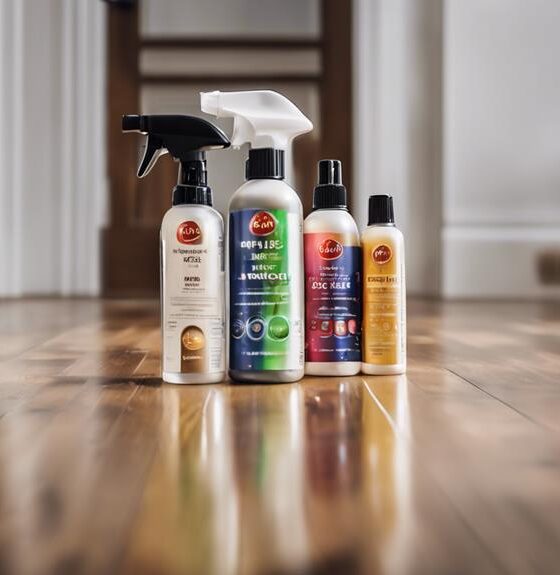Appliances
Top 4 Wireless Smart Home Entertainment Systems
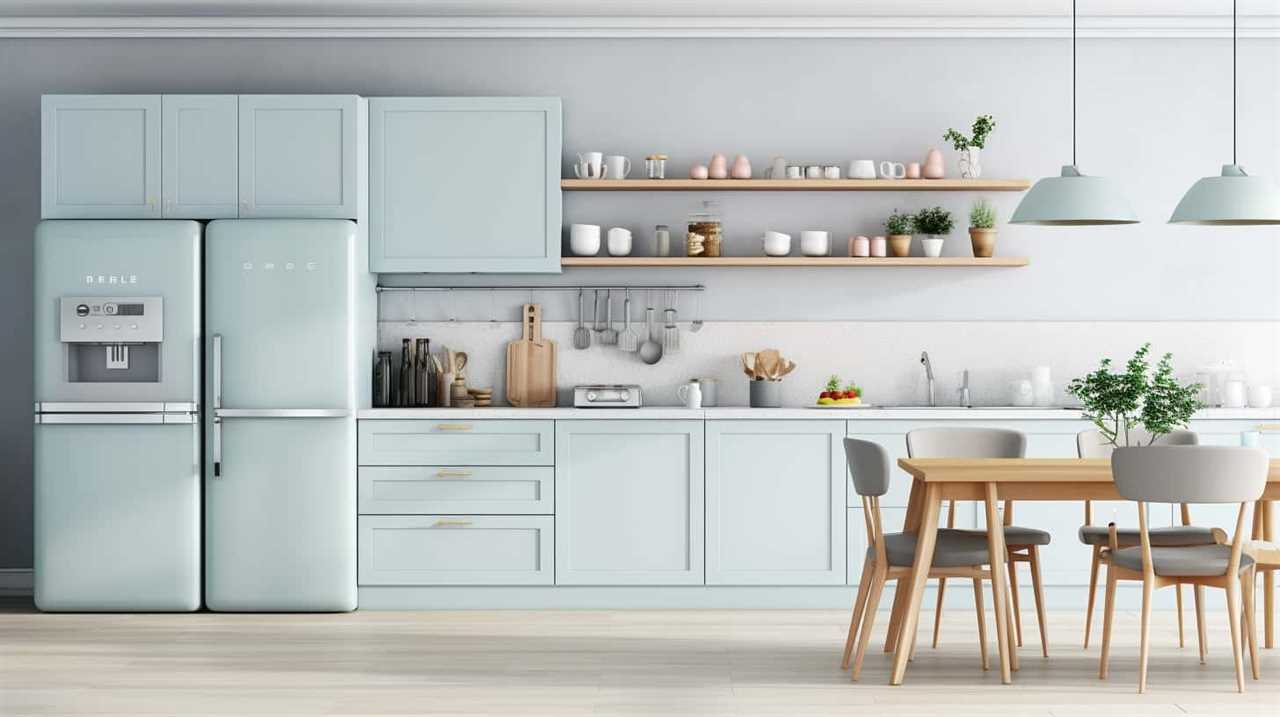
Are you searching for the ultimate wireless smart home entertainment system? Look no further! This guide will cover the top 4 systems that are guaranteed to enhance your entertainment experience.
Our investigation aims to uncover the truth about these cutting-edge technologies, providing you with the knowledge you need to make an informed decision. With our mastery-focused language, we will delve into the features and capabilities of each system, ensuring that you can navigate the complex world of smart home entertainment with confidence.
From the Sonos Beam Soundbar to the Amazon Echo Studio, the Bose SoundTouch 300, and the Samsung HW-Q90R Soundbar, prepare to be amazed by the possibilities that await you.
Let’s dive in and discover your perfect wireless smart home entertainment system!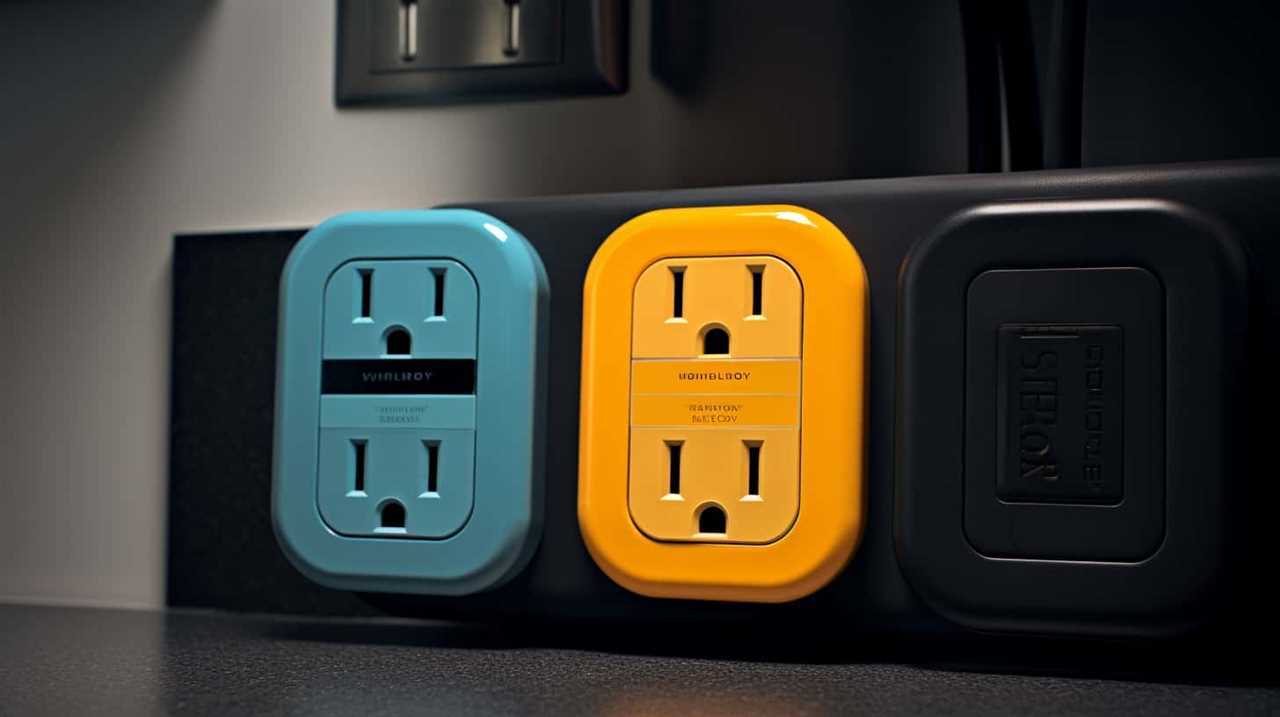
Key Takeaways
- Sonos Beam Soundbar: Sleek design, exceptional audio quality, easy setup, custom-designed tweeter
- Amazon Echo Studio: Powerful and immersive, surround sound capabilities, voice control, integration with smart home devices
- Bose SoundTouch 300: Excellently designed, clear and detailed sound, Wi-Fi and Bluetooth connectivity options, various setup configurations
- Samsung HW-Q90R Soundbar: Immersive audio experience, seamless connectivity options, Dolby Atmos technology, wireless subwoofer, adaptive sound technology
Sonos Beam Soundbar
We absolutely love the Sonos Beam Soundbar for its sleek design and exceptional audio quality. When it comes to smart home integration, this device is top-notch. With built-in voice control, the Sonos Beam seamlessly integrates with popular smart home platforms like Amazon Alexa and Google Assistant. This allows you to control your soundbar using simple voice commands, making your entertainment experience even more convenient.
Setting up the Sonos Beam for smart home integration is a breeze. Just connect it to your Wi-Fi network, download the Sonos app, and follow the step-by-step instructions. Once connected, you can use voice commands to play your favorite music, adjust the volume, or even control other smart home devices in your ecosystem. It’s like having your own personal assistant right in your living room.
In terms of audio quality, the Sonos Beam delivers impressive performance. It features a custom-designed tweeter, three passive radiators, and five class-D amplifiers, all working together to produce clear and immersive sound. Whether you’re watching movies, playing games, or listening to music, the Beam ensures that every sound detail is crisp and rich.
Amazon Echo Studio
The Amazon Echo Studio offers a powerful and immersive smart home entertainment experience. With its surround sound capabilities, voice control, and integration with smart home devices, the Echo Studio is a top choice for those seeking a high-quality audio and entertainment solution.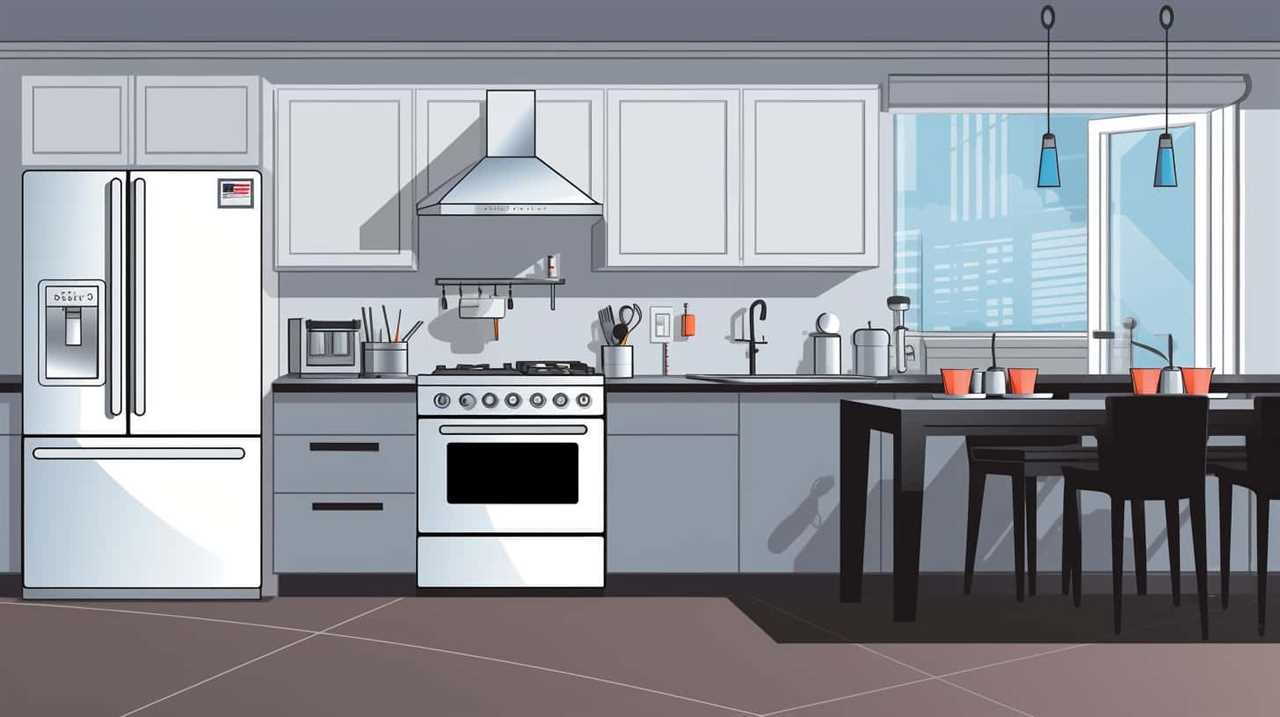
Surround sound capabilities: The Echo Studio features a 5-speaker setup, including a 3-inch neodymium woofer and a 1-inch tweeter for each channel. This allows for a truly immersive audio experience, with rich bass and crystal-clear highs.
Voice control: The Echo Studio is equipped with Amazon’s virtual assistant, Alexa, which allows you to control the speaker and other connected smart home devices using just your voice. You can ask Alexa to play music, adjust the volume, switch between different inputs, and even control compatible lights, thermostats, and more.
Integration with smart home devices: In addition to voice control, the Echo Studio seamlessly integrates with a wide range of smart home devices, such as smart TVs, streaming devices, and home automation systems. This means you can control your entire entertainment setup, from audio to video, all from one central hub.
With its impressive surround sound capabilities, voice control, and integration with smart home devices, the Amazon Echo Studio is a versatile and powerful smart home entertainment system that delivers a truly immersive audio experience.
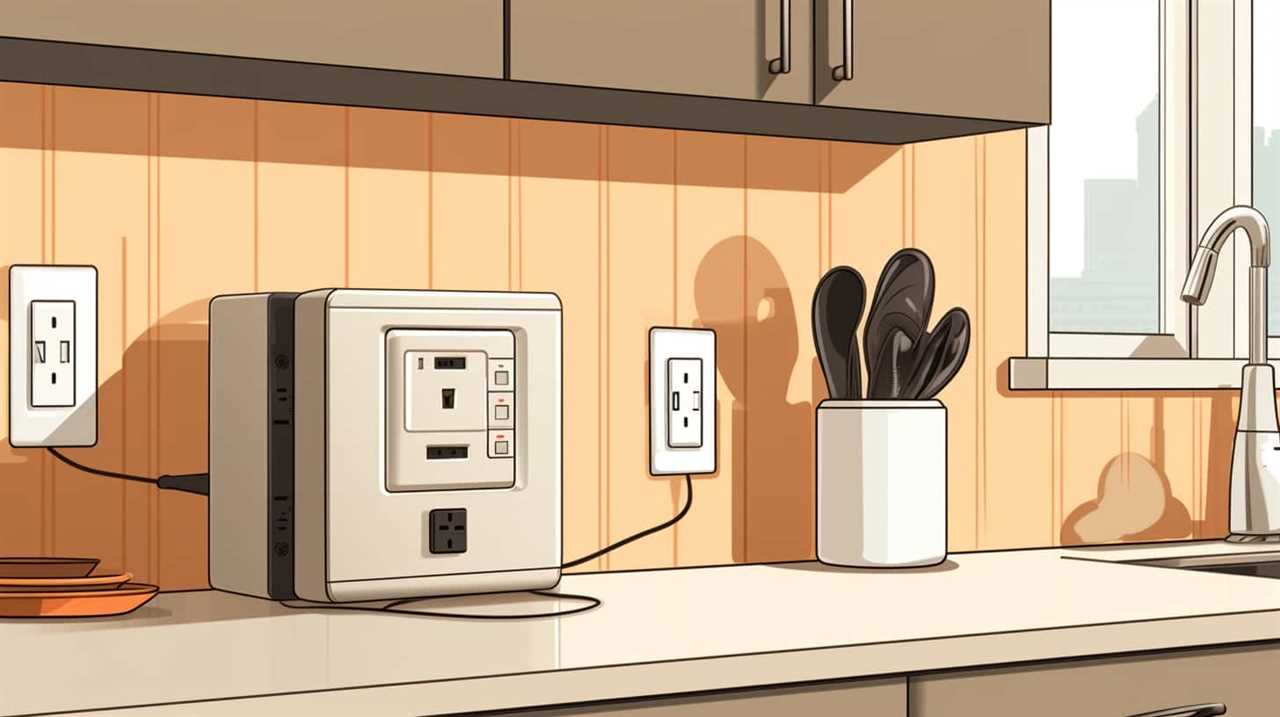
Bose SoundTouch 300
The Bose SoundTouch 300 is an excellently designed wireless smart home entertainment system, which frequently offers a seamless and immersive audio experience. When it comes to sound quality, the SoundTouch 300 stands out among its competitors. Its advanced technologies and custom drivers deliver clear and detailed sound, with deep bass and crisp highs. To highlight the sound quality comparison, let’s take a look at the table below:
| Bose SoundTouch 300 | |
|---|---|
| Sound Quality | Clear and detailed sound with deep bass and crisp highs |
| Setup Options | Wi-Fi and Bluetooth connectivity options |
| Connectivity | HDMI ARC, optical audio input, and Ethernet port |
The setup and connectivity options of the SoundTouch 300 are also noteworthy. It offers both Wi-Fi and Bluetooth connectivity, providing flexibility in how you connect your devices. Additionally, it features an HDMI ARC port, optical audio input, and an Ethernet port, allowing for various setup configurations. Whether you prefer a wired or wireless connection, the SoundTouch 300 has you covered.
Samsung HW-Q90R Soundbar
One option that stands out among the top wireless smart home entertainment systems is the Samsung HW-Q90R Soundbar. This soundbar is designed to provide an immersive audio experience, bringing your movies, music, and games to life with its powerful and dynamic sound.
With seamless connectivity options, the Samsung HW-Q90R Soundbar allows you to easily connect and control all your devices. Whether you want to stream music from your smartphone or connect your TV, this soundbar offers multiple options, including Bluetooth, Wi-Fi, and HDMI.
Here are three key features that make the Samsung HW-Q90R Soundbar a top choice for your smart home entertainment system:
- Dolby Atmos Technology: This soundbar is equipped with Dolby Atmos technology, which creates a three-dimensional sound experience by bouncing sound off the ceiling. This results in a more realistic and immersive audio experience, making you feel like you’re right in the middle of the action.
- Wireless Subwoofer: The Samsung HW-Q90R Soundbar comes with a wireless subwoofer that delivers deep and powerful bass. This enhances the overall audio experience, adding depth and richness to your favorite movies and music.
- Adaptive Sound: This soundbar features adaptive sound technology that analyzes the audio content in real-time and adjusts the sound settings accordingly. This ensures that you always get the best audio quality, whether you’re watching a quiet dialogue or an action-packed scene.
Frequently Asked Questions
Can the Sonos Beam Soundbar Be Used With a Non-Sonos TV or Audio System?
Yes, the Sonos Beam soundbar can be used with a non-Sonos TV or audio system. While Sonos products are designed to work seamlessly together, the Beam soundbar also offers compatibility with other devices.
It can be connected to any TV with an HDMI ARC or optical audio output. Additionally, it can be used with other audio systems by connecting through the Beam’s HDMI or optical inputs.
Please note that the Sonos Beam doesn’t require an Amazon Echo Studio hub for operation.

Does the Amazon Echo Studio Require a Separate Hub or Can It Be Controlled Directly From a Smartphone?
The Amazon Echo Studio doesn’t require a separate hub and can be controlled directly from a smartphone. With its smartphone compatibility, you can easily manage and control the Echo Studio using the Alexa app on your smartphone.
This allows for convenient voice control and access to a wide range of features and functions.
As for the Sonos Beam soundbar, it offers voice control options through popular voice assistants like Amazon Alexa and Google Assistant, providing a seamless and hands-free entertainment experience.
What Is the Maximum Bluetooth Range for the Bose Soundtouch 300?
The maximum Bluetooth range for the Bose SoundTouch 300 is an impressive feature that sets it apart from other wireless smart home entertainment systems. With a range of up to 30 feet, this device allows for seamless connectivity and freedom of movement within your home.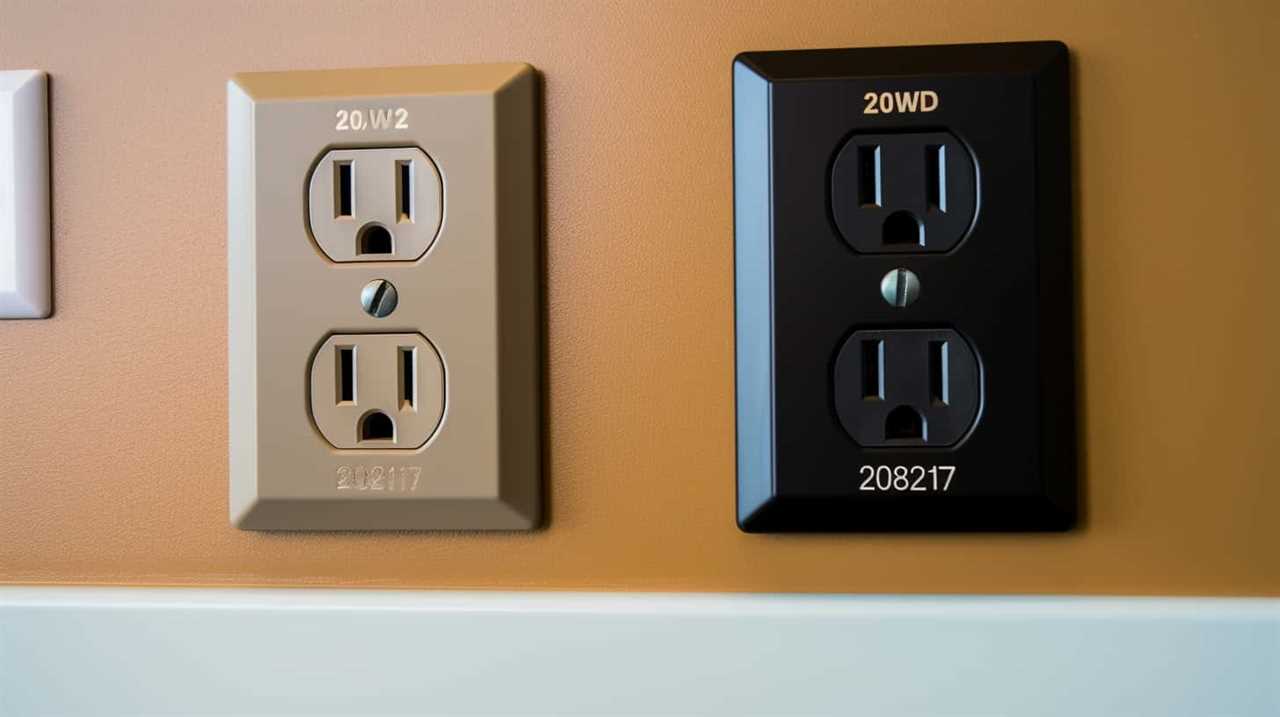
Whether you’re hosting a party or simply enjoying your favorite music, the SoundTouch 300 ensures that you can stay connected and immersed in high-quality audio without any interruptions.
Can the Samsung HW-Q90R Soundbar Be Wall-Mounted?
Yes, the Samsung HW-Q90R soundbar can be wall-mounted. There are several wall mounting options available, including using a wall bracket or a universal soundbar mount.
To securely mount the soundbar, it’s recommended to follow the specific instructions provided by Samsung for installation. Additionally, you may need to purchase any necessary accessories, such as screws or brackets, depending on the mounting option chosen.
Ensuring proper installation is crucial for a secure and stable wall-mounted soundbar setup.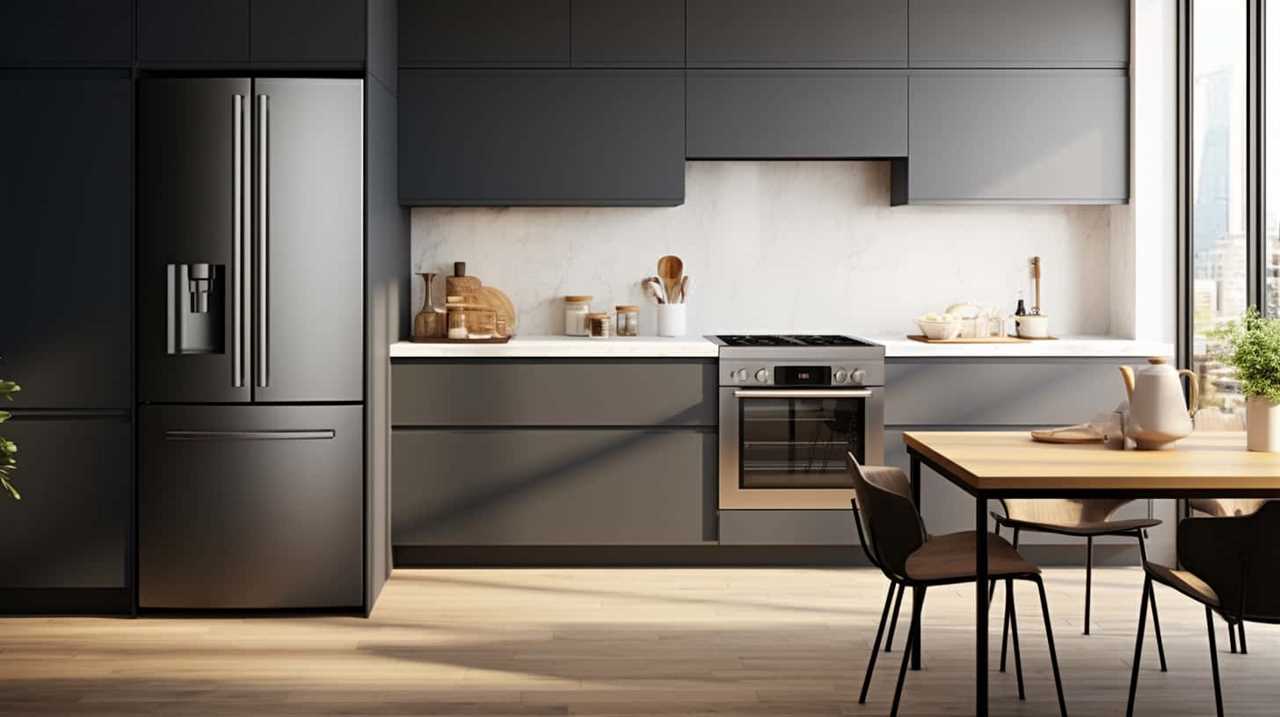
Are There Any Voice Control Compatibility Limitations for the Sonos Beam Soundbar?
When it comes to voice control compatibility for the Sonos Beam Soundbar, there are a few limitations to be aware of.
While the Beam supports voice commands through Amazon Alexa and Google Assistant, it doesn’t have built-in support for Apple’s Siri. However, you can still use Siri with the Sonos Beam by connecting it to an Apple device like an iPhone or iPad.
Can I incorporate Green Smart Home Tech into a Wireless Smart Home Entertainment System?
Yes, it is possible to incorporate green smart home technology into a wireless smart home entertainment system. By utilizing energy-efficient devices, smart thermostats, and sustainable materials, you can create an eco-friendly entertainment setup. This allows for a more efficient and environmentally conscious home entertainment experience.
Conclusion
In conclusion, when it comes to wireless smart home entertainment systems, Sonos Beam Soundbar, Amazon Echo Studio, Bose SoundTouch 300, and Samsung HW-Q90R Soundbar are top contenders.
While some may argue that these systems can be expensive, the immersive audio experience they provide is well worth the investment.
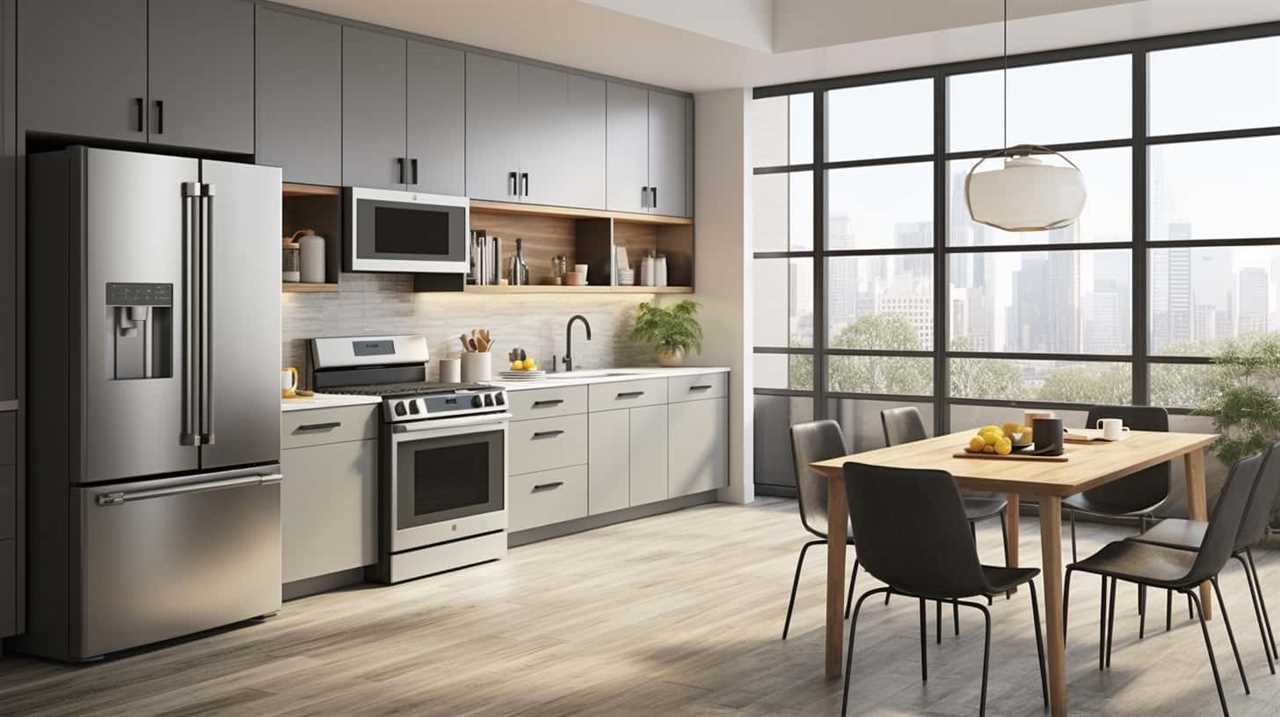
Transform your living room into a cinematic haven and indulge in a truly immersive entertainment experience with these cutting-edge systems.
- About the Author
- Latest Posts
Introducing Charles, the Editor in Chief at ByRetreat, whose passion for interior design and editorial excellence elevates every remote workspace to new heights. With his keen eye for detail, impeccable taste, and expertise in design, Charles brings a wealth of knowledge and creativity to the ByRetreat team.
As the Editor in Chief of a renowned lifestyle blog, Charles has honed his skills in curating captivating content and staying up-to-date with the latest trends in interior design. His deep understanding of aesthetics and the power of storytelling through design enables him to create remote workspaces that are not only visually stunning but also rich in personality and meaning.
Appliances
Can You Use Water Instead of Milk for Pancakes
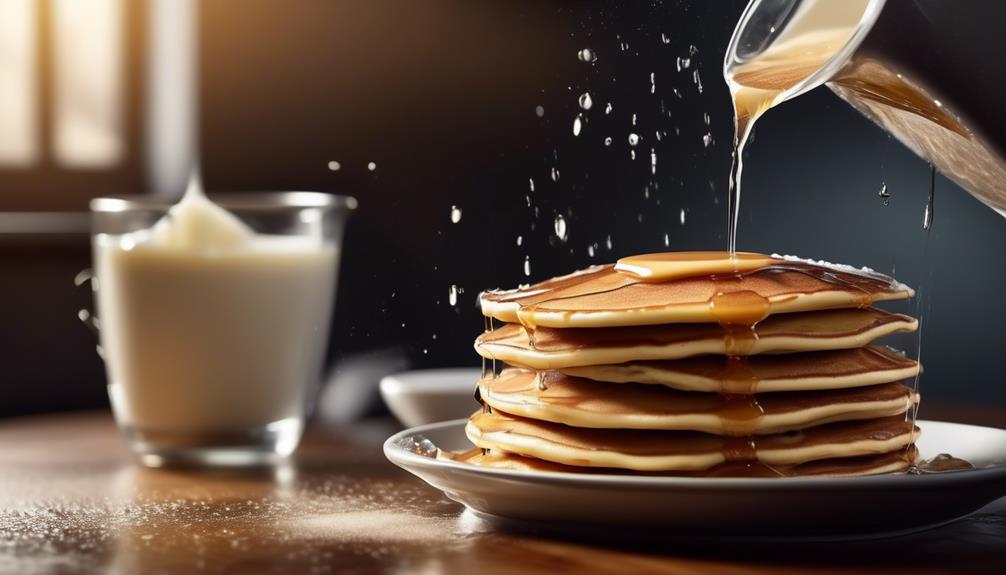
We’ve all been in that situation, questioning whether we can substitute water for milk in pancakes. The dilemma typically arises when we run out of milk but still have a hankering for a pile of scrumptious, fluffy pancakes. The answer is not as simple as it may seem.
Translated in US English: We’ve all been there, wondering if we can use water instead of milk for pancakes. The question arises when we’re out of milk but still craving a stack of delicious, fluffy pancakes. The answer is not as straightforward as one might think.
While water can technically be used as a substitute for milk in pancake batter, there are some important factors to consider. From the impact on texture to the potential changes in flavor profile, the decision to use water instead of milk can significantly alter the outcome of your pancakes.
But before we jump into the specifics, it's essential to understand the role that milk plays in pancake batter and how substituting water can affect the final result.
Key Takeaways
- Using water instead of milk in pancake batter alters the texture and flavor of the pancakes.
- Adjustments to flavoring agents, cooking time, and heat level are necessary when using water in pancake batter.
- Pancakes made with water may have a thinner consistency and slightly less rich flavor.
- Water lacks fat and protein content, which affects the texture of pancakes, requiring precise mixing techniques and cooking temperature control.
The Impact of Using Water in Pancake Batter
Using water instead of milk in pancake batter can significantly impact the texture and flavor of the final product. When water is used as a substitute for milk, the flavor impact is noticeable due to the absence of the creaminess and richness that milk provides. The result is a slightly less flavorful pancake. Additionally, the cooking time may be affected when using water instead of milk. Since water evaporates more quickly than milk, the pancakes may cook faster, requiring a keen eye to prevent overcooking.
Ingredient substitution, such as replacing milk with water, requires recipe modification to maintain the desired taste and texture of the pancakes. To counteract the flavor impact, incorporating additional flavoring agents such as vanilla extract or sugar can help enhance the taste. Adjusting the cooking time and heat level is also essential when using water in pancake batter to ensure that the pancakes are cooked through without becoming dry.
Adjusting the Consistency of Pancake Batter
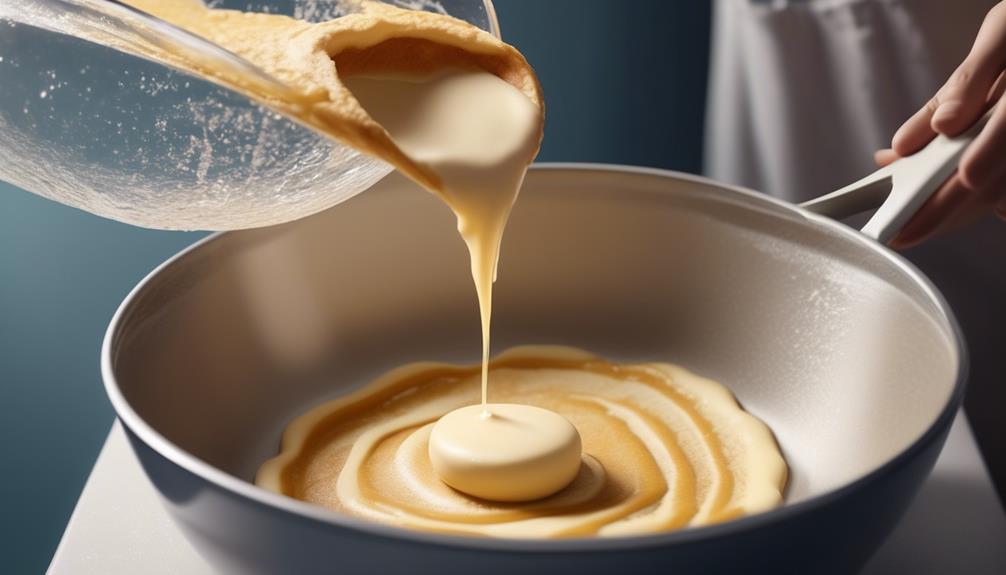
When it comes to adjusting the consistency of pancake batter, the choice between using water or milk can have a significant impact on the texture of the pancakes. Research shows that using water instead of milk can result in a thinner batter, which may lead to lighter and fluffier pancakes.
Understanding the differences in consistency and their effects on pancake texture can help home cooks make informed decisions about their pancake batter.
Water Vs. Milk Consistency
To achieve the desired consistency of pancake batter when using water instead of milk, it's essential to adjust the liquid quantity gradually and mix until the batter reaches a smooth, pourable texture. The key lies in making incremental additions of water while monitoring the batter's consistency. This step ensures that the pancakes won't become overly dense or too thin.
When comparing the taste and texture of pancakes made with water versus milk, the use of water may result in a slightly less rich flavor and a marginally thinner texture. To compensate for this, precise cooking techniques and batter adjustments are necessary. By carefully adjusting the water quantity and employing proper mixing techniques, it's possible to achieve a satisfactory texture and overall quality in pancakes made with water, akin to those made with milk.
Impact on Pancake Texture
In assessing the impact of using water instead of milk on pancake texture, it's crucial to carefully adjust the consistency of the pancake batter to achieve an optimal result. When substituting water for milk in pancake batter, the cooking techniques and ingredient impact are essential factors to consider.
Water has a different impact on the texture of pancakes compared to milk due to its lack of fat and protein content. To counteract this, it's important to make adjustments to the batter to maintain the desired texture. By incorporating appropriate cooking techniques, such as mixing the batter to the right consistency and controlling the cooking temperature, the impact of water substitution can be minimized.
Understanding the ingredient impact of water in pancake batter is fundamental for achieving the desired texture when using it as a substitute for milk.
Potential Changes in Flavor Profile
When using water instead of milk for pancakes, we need to consider the potential changes in flavor profile. The flavor of the pancakes may differ due to the absence of milk's creamy and slightly sweet taste, impacting the overall taste experience.
Additionally, the texture of the pancakes could vary, potentially affecting the cooking process and requiring adjustments to achieve the desired result.
Flavor Difference
After substituting water for milk in pancake batter, the flavor profile may undergo subtle changes due to the absence of milk's inherent creaminess and richness. The flavor comparison between pancakes made with water and those made with milk reveals that the use of water may result in a slightly blander taste. This is because milk adds a touch of sweetness and a creamy undertone, enhancing the overall flavor.
Additionally, the cooking techniques may need to be adjusted to compensate for the lack of richness when using water. For example, adding a bit of extra vanilla extract or a pinch of salt can help to elevate the flavor of pancakes made with water.
It's important to note that while the flavor may differ, the overall texture and fluffiness of the pancakes can remain consistent with proper adjustments.
Texture Variation
The flavor changes resulting from using water instead of milk in pancake batter prompt an exploration of potential variations in texture, which can further impact the overall flavor profile.
- Flavor comparison: The texture of pancakes made with water tends to be slightly denser and less rich compared to those made with milk. This can affect the way the flavors are perceived, as a lighter texture may allow the taste of other ingredients to come through more prominently.
- Cooking techniques: The choice of liquid in pancake batter can also influence cooking techniques. Pancakes made with water may require slightly different heat management and cooking times to achieve the desired texture, potentially affecting the overall flavor development during the cooking process.
- Ingredient substitution, Flavor experimentation: Experimenting with different liquids, such as water, buttermilk, or various plant-based alternatives, can yield diverse texture variations and flavor profiles, offering an opportunity for culinary exploration.
Cooking Adjustments
Using water instead of milk in pancake batter can lead to adjustments in cooking techniques, potentially resulting in changes to the overall flavor profile of the pancakes.
When adjusting flavor for pancakes made with water, it's essential to consider the potential lack of richness that milk provides. To compensate for this, adding a bit more vanilla extract or melted butter to the batter can enhance the flavor profile.
Additionally, since the consistency of the batter made with water may be thinner than that made with milk, it's important to adjust the cooking time and temperature accordingly. A thinner batter may cook faster, so keeping a close eye on the pancakes to prevent overcooking is crucial.
Furthermore, a consistency comparison between the two batters can help determine the optimal cooking adjustments needed to achieve the desired flavor and texture.
Understanding the Role of Milk in Pancakes

Understanding the important role of milk in pancakes adds depth to our appreciation of this staple breakfast item. Milk serves as a crucial ingredient in pancake batter, influencing not only the texture but also the flavor profile of the final product.
Here are three key aspects to consider when understanding the role of milk in pancakes:
- Role of Buttermilk: Buttermilk, a common type of milk used in pancake recipes, contributes to the tenderness and moistness of the pancakes. Its slightly acidic nature also activates the leavening agents, promoting a light and fluffy texture.
- Nutritional Benefits: Milk is a source of essential nutrients such as calcium, protein, and vitamin D. These nutrients enrich the pancake batter, enhancing its nutritional value. Additionally, the protein in milk aids in providing structure to the pancakes, resulting in a desirable texture.
- Flavor and Texture: The milk's fat content influences the richness and tenderness of the pancakes. Whole milk contributes to a richer flavor and a more tender crumb, while lower-fat milk options may yield a slightly lighter texture.
Understanding the multifaceted role of milk in pancake preparation empowers us to make informed decisions when considering alternative ingredients.
Tips for Substituting Water for Milk
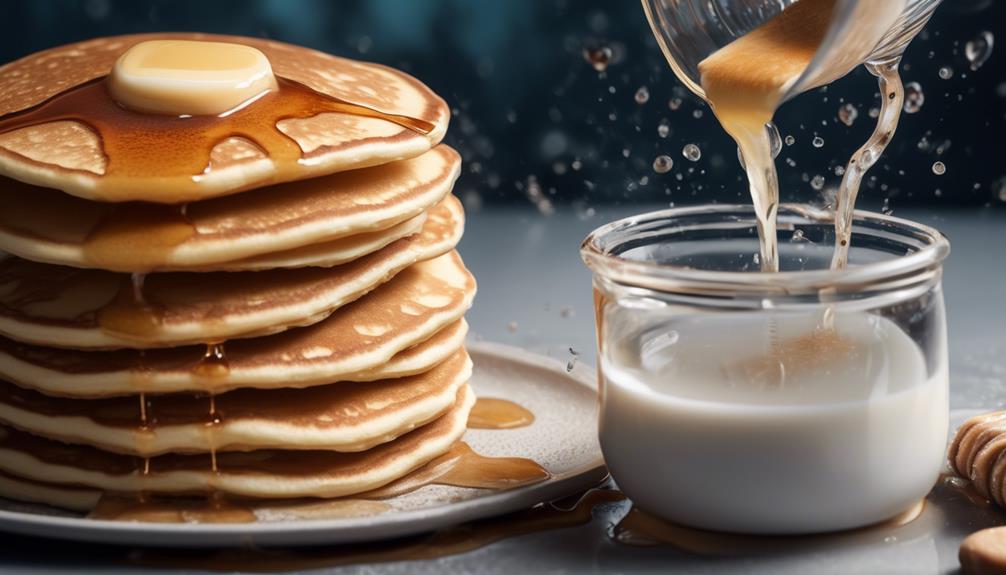
Pancake enthusiasts seeking a dairy-free alternative may find that substituting water for milk in pancake batter can significantly impact the final texture and flavor profile.
When making this substitution, it's essential to consider the following tips to ensure that the pancakes turn out delicious and fluffy.
Firstly, adjusting the amount of water is crucial. Since water is thinner than milk, using the same quantity may result in a runny batter, leading to flat and tough pancakes. It's advisable to start by using slightly less water than the milk quantity stated in the recipe, then gradually add more if needed to achieve the desired consistency.
Secondly, incorporating a fat source into the batter can help compensate for the richness lost by omitting milk. Adding melted butter or oil can improve the texture and flavor of the pancakes.
Lastly, for those concerned about flavor, consider using flavored water such as almond or coconut water to enhance the taste. Conducting a flavor comparison between different types of water can help determine the best option for achieving delicious dairy-free pancakes.
Applying these substituting techniques and flavor comparison can result in successful and enjoyable water-based pancake recipes.
Exploring Texture Variations in Pancakes
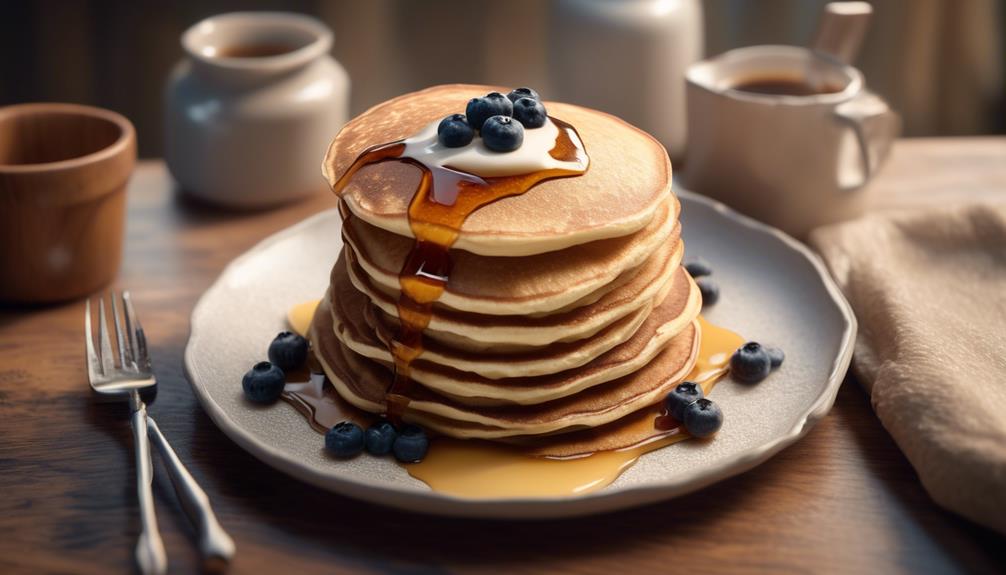
Texture variations in pancakes can greatly influence the overall dining experience, impacting factors such as mouthfeel and perceived quality. When comparing textures, it's essential to consider the cooking techniques and ingredients used.
Here's a breakdown of the texture comparison in pancakes:
- Fluffy Pancakes: Achieving a fluffy texture often involves using buttermilk or yogurt in the batter. These acidic ingredients react with the leavening agents, resulting in a light and airy pancake. Additionally, gently folding whipped egg whites into the batter can contribute to a fluffy texture.
- Dense and Moist Pancakes: For a denser and moister texture, incorporating ingredients such as mashed bananas, pumpkin puree, or ricotta cheese can be beneficial. These ingredients add moisture and richness to the batter, resulting in a more decadent pancake.
- Crispy Edges and Tender Center: To achieve pancakes with crispy edges and a tender center, using a cast-iron skillet or griddle can make a difference. The even heat distribution and retention of these cooking surfaces can create a desirable contrast in textures.
Understanding these texture comparisons and the cooking techniques involved can empower individuals to customize their pancake experience according to their preferences.
The Science Behind Pancake Ingredients

Considering the chemical reactions and physical properties of various ingredients is essential to understanding the science behind pancake preparation. When it comes to ingredient substitution in pancake recipes, it's important to recognize that each component plays a crucial role in the chemical reactions that occur during the cooking process.
For instance, when substituting water for milk, it's necessary to understand how this change affects the overall chemical composition of the batter. Milk contains proteins, fats, and sugars, which contribute to the browning, texture, and flavor of the pancakes due to the Maillard reaction. Substituting water for milk can alter the Maillard reaction, resulting in a different flavor profile and texture.
Additionally, the leavening agent, typically baking powder, reacts with the acidic component in the batter, often found in buttermilk or yogurt, to produce carbon dioxide gas, which causes the batter to rise. Understanding the chemical reactions between the leavening agent and the acidic component is crucial when considering ingredient substitutions.
Experimenting With Alternative Liquid Options

Exploring alternative liquid options can provide valuable insights into the potential effects on pancake batter consistency and flavor profiles. When experimenting with different liquid options for pancakes, it's essential to consider the impact on flavor and texture.
Here's what we found:
- Flavor Comparison: We conducted a flavor comparison using water, almond milk, and buttermilk as alternative liquid options in pancake batter. The water-based pancakes had a milder taste, allowing the flavors of additional ingredients, such as vanilla or cinnamon, to shine through. Almond milk imparted a slightly nutty undertone, complementing the overall taste of the pancakes. Buttermilk added a tangy richness, enhancing the flavor complexity.
- Texture Experiment: We observed significant differences in texture when using alternative liquid options. Water produced pancakes with a lighter, somewhat crisper texture. Almond milk yielded a slightly denser and moister texture, while buttermilk resulted in a fluffier and tender crumb.
- Cooking Differences, Milk Alternatives: Additionally, we noted variations in cooking times and browning when using different liquid options. Water-based pancakes required slightly longer cooking times and exhibited less browning compared to those made with milk alternatives.
Frequently Asked Questions
Can You Use Flavored Water, Like Coconut or Almond Water, Instead of Regular Water for Pancakes?
Using flavored water, like coconut or almond water, for pancakes can enhance taste but may alter texture due to lower fat and protein content.
While it's an option, consider its impact on dietary restrictions, like nut allergies.
Alternative liquids for pancake batter include milk substitutes such as soy or oat milk, maintaining texture and flavor.
Understanding the impact of different liquids on taste and texture can help tailor pancake recipes to individual preferences and dietary needs.
Will Using Water Instead of Milk Affect the Nutritional Value of the Pancakes?
Using water instead of milk for pancakes can affect the nutritional value. The taste may be impacted, but cooking techniques can help minimize it.
Water lacks the natural fats, proteins, and sugars found in milk, which contribute to the pancake's texture and flavor.
While water can still be used, it's important to adjust the recipe accordingly to maintain the desired texture and flavor.
Can You Use Carbonated Water or Soda Water as a Substitute for Milk in Pancake Batter?
Yes, carbonated water or soda water can be used as a substitute for milk in pancake batter. The carbonation effect helps in creating a lighter and fluffier texture.
When using carbonated water, it's important to consider the leavening agent in the recipe, such as baking soda, as the carbonation can affect its efficiency. Adjustments may be needed to ensure the pancakes rise properly.
What Is the Best Way to Ensure That Pancakes Made With Water Instead of Milk Are Still Fluffy?
To ensure fluffy pancakes using water instead of milk, it's essential to incorporate alternative ingredients. Research suggests that adding a bit of carbonated water can help maintain fluffiness. The carbonation creates tiny air pockets, resulting in a lighter texture.
Additionally, using buttermilk or yogurt instead of water can also enhance fluffiness due to their acidic nature. Experimenting with these alternatives can yield deliciously fluffy pancakes without compromising on taste or texture.
Are There Any Special Considerations to Keep in Mind When Using Water Instead of Milk for Pancakes at High Altitudes?
At high altitudes, adjustments are crucial for pancake texture. Using water instead of milk for pancakes at high altitudes requires careful consideration.
Water tends to evaporate faster, impacting the moisture content and potentially making the pancakes drier. Adjusting the batter consistency and cooking time can help maintain the desired texture.
Additionally, the taste difference between water and milk in pancakes may be more noticeable at high altitudes due to the altered cooking conditions.
Conclusion
In conclusion, while water can be used as a substitute for milk in pancake batter, the impact on the flavor profile and texture may not be ideal.
The science behind pancake ingredients suggests that milk plays a crucial role in creating the perfect consistency and taste.
So, while experimenting with alternative liquid options can be intriguing, it's important to consider the potential changes in the overall pancake experience.
- About the Author
- Latest Posts
Introducing Ron, the home decor aficionado at ByRetreat, whose passion for creating beautiful and inviting spaces is at the heart of his work. With his deep knowledge of home decor and his innate sense of style, Ron brings a wealth of expertise and a keen eye for detail to the ByRetreat team.
Ron’s love for home decor goes beyond aesthetics; he understands that our surroundings play a significant role in our overall well-being and productivity. With this in mind, Ron is dedicated to transforming remote workspaces into havens of comfort, functionality, and beauty.
Appliances
Bulb Base Types
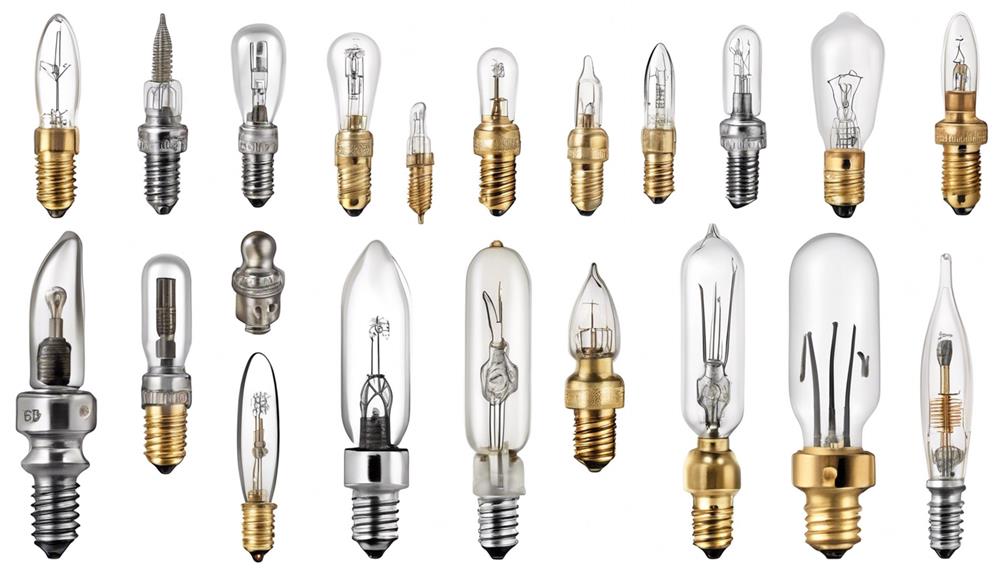
We understand that discussing bulb base types may not be the most exciting topic, but it is important. Knowing the different types of bulb bases is crucial in selecting the correct bulb for your fixtures.
It can be a bit overwhelming with all the different options out there, but knowing the basics can make a world of difference in your lighting choices. So, let's shed some light on the various bulb base types and why they matter.
Key Takeaways
- E26 Base is the commonly used standard for light bulbs in the United States and Canada, accommodating a wide range of bulb types and compatible with dimmable options.
- E12 Base, also known as candelabra base, is commonly found in chandeliers, sconces, and small lamps, and is compatible with 120 volts.
- GU10 Base is compact in size, energy-efficient, and suitable for various lighting applications, while G4 Base is low-voltage and ideal for compact spaces and landscape lighting.
- G11 Base is used in CFLs and UV germicidal lamps, while R7s Base is commonly used in halogen and LED floodlights, with a linear double-ended design.
E26 Base
The E26 base, also known as the medium screw base, is a commonly used standard for light bulbs in the United States and Canada. It's characterized by its 26mm diameter and is often used for incandescent, compact fluorescent, and LED bulbs.
When considering energy efficiency, the E26 base accommodates a wide range of bulb types, including energy-saving LED bulbs that consume significantly less power compared to traditional incandescent bulbs. Additionally, these bases are designed to support various color temperature options, allowing users to select the desired warmth or coolness of light for different settings. This versatility is particularly advantageous for creating specific atmospheres in residential, commercial, or industrial spaces.
Moreover, the E26 base is compatible with dimmable options, enabling users to adjust the brightness of their lighting according to their preferences and needs. This feature adds a layer of flexibility and customization, enhancing the overall lighting experience.
Consequently, the E26 base stands as a versatile and efficient choice for diverse lighting applications.
E12 Base
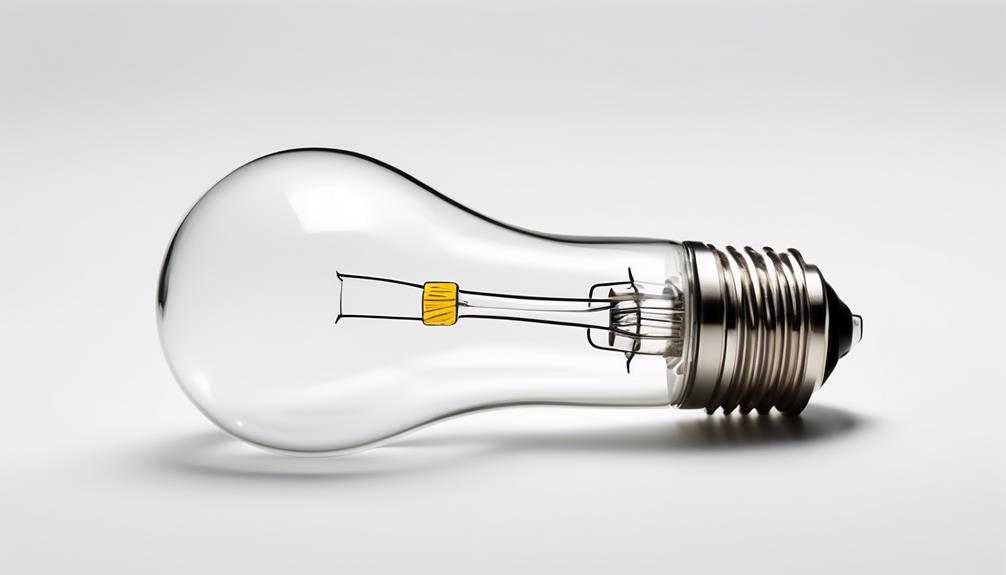
Let's first consider the size and compatibility of E12 bases, as these factors are crucial for selecting the right bulb for your fixture.
Then, we'll explore the common applications where E12 bases are commonly used, shedding light on their versatility.
Size and Compatibility
Understanding the size and compatibility of the E12 base is crucial for selecting the appropriate bulb for your lighting fixture. The E12 base, also known as candelabra base, has a diameter of 12mm between the threads and is commonly found in chandeliers, sconces, and small lamps. The E12 base is compatible with 120 volts and is designed for smaller, decorative bulbs. It is important to note that using a bulb with an incompatible base size can lead to electrical issues and potential damage to the fixture. Below is a table summarizing the key specifications of the E12 base:
| Specification | Value |
|---|---|
| Bulb Size | Small, decorative |
| Voltage | 120V |
| Base Shape | Cylindrical |
| Base Material | Typically metal |
Common Applications
settings
- Provides a warm and inviting glow
- Compatible with 120 volts
- Commonly used in decorative string lights and outdoor wall lanterns
- Offers aesthetically pleasing illumination
- Withstands outdoor conditions
- Versatile choice for both indoor and outdoor lighting requirements.
Lighting Options
After discussing the common applications of the E12 base, it is important to explore the various lighting options available for this bulb base type. When it comes to E12 base lighting options, there are several choices to consider. From energy-efficient LED bulbs to smart bulbs, the E12 base can accommodate various lighting needs. For outdoor lighting, E12 base bulbs are suitable for decorative fixtures, adding an aesthetic touch to outdoor spaces. Here is a table summarizing the lighting options for the E12 base:
| Lighting Option | Description | Best Use |
|---|---|---|
| LED Bulbs | Highly energy-efficient and long-lasting. | Indoor lighting |
| Smart Bulbs | Can be controlled remotely and offer versatility. | Home automation systems |
| Decorative Fixtures | Enhance aesthetic appeal in outdoor spaces. | Outdoor lighting |
These lighting options cater to different preferences and requirements, providing versatility for E12 base users.
GU10 Base
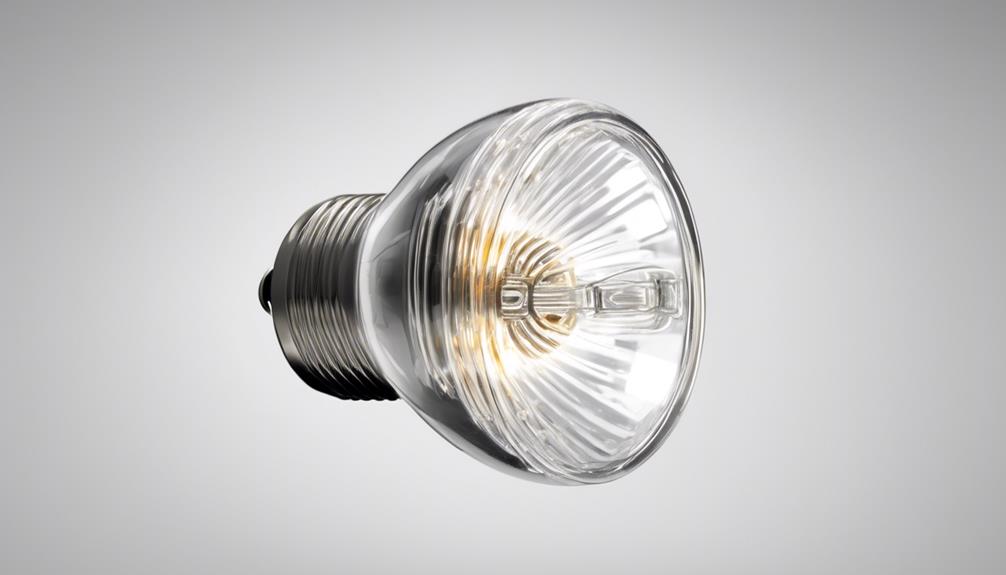
GU10 base is a versatile and widely used type of bulb base in the lighting industry. It's known for its compact size and twist-lock design, making it suitable for various lighting applications.
When considering GU10 base bulbs, there are several important factors to take into account:
- Color Temperature and Dimming: GU10 base bulbs are available in a range of color temperatures, from warm white to cool white, allowing for customization based on the desired ambiance. Additionally, many GU10 bulbs are dimmable, providing flexibility in adjusting the light output to suit different settings.
- Energy Efficiency and Heat Output: GU10 bulbs are lauded for their energy efficiency, consuming less power while delivering bright illumination. This not only reduces electricity costs but also contributes to environmental sustainability. Furthermore, GU10 bulbs produce minimal heat output, making them ideal for use in fixtures where heat management is crucial.
G4 Base
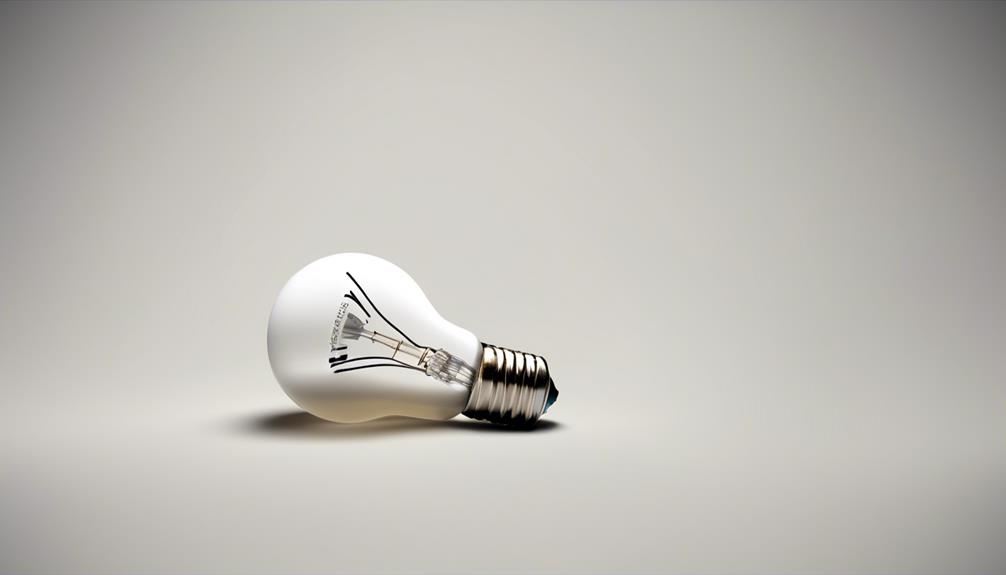
Let's start by examining the G4 base, which is commonly used in low-voltage halogen lamps and LED bulbs.
We'll explore its applications in various lighting fixtures and the specific compatibility requirements for G4 base bulbs.
Understanding the G4 base will help us make informed decisions when selecting the right bulb for our lighting needs.
G4 Base Overview
The G4 base is a low-voltage, bi-pin halogen bulb base commonly used in decorative and task lighting fixtures. Its voltage typically ranges from 6 to 12 volts, making it ideal for various low-voltage applications.
The dimensions of the G4 base are standardized, with a pin spacing of 4mm between the two pins. This base is designed to accommodate small, compact bulbs, often used in tight spaces where traditional bulbs may not fit.
The G4 base is known for its energy efficiency and bright light output, making it suitable for a wide range of lighting needs.
G4 Base Applications
In various lighting fixtures, the G4 base is utilized for its low-voltage capability, standardized dimensions, and suitability for compact spaces.
G4 base bulbs are commonly used in landscape lighting due to their small size and energy-efficient operation. They provide adequate illumination for pathways, gardens, and outdoor areas while consuming minimal power.
Additionally, the G4 base is popular in automotive lighting, especially in small vehicles and motorcycles. The compact nature of G4 base bulbs makes them ideal for use in vehicle headlights, tail lights, and interior lighting. Their low-voltage capability also aligns with the electrical systems of many automobiles.
This versatility in applications, combined with their energy efficiency, makes G4 base bulbs a popular choice in both landscape and automotive lighting.
G4 Base Compatibility
When assessing G4 base compatibility, we must consider the specific requirements and electrical characteristics of the lighting fixture. The voltage of the G4 base is a crucial factor to ensure proper compatibility. It's essential to match the voltage rating of the bulb with the voltage supplied by the fixture to prevent damage and ensure optimal performance.
Additionally, the wattage of the G4 base plays a significant role in compatibility. Exceeding the maximum wattage could lead to overheating and potential hazards, while using a lower wattage may result in insufficient brightness. Therefore, understanding the wattage limitations of the fixture is essential for selecting the appropriate G4 base bulb.
To summarize:
- Voltage Compatibility: Match the voltage rating of the G4 base with the voltage supplied by the fixture.
- Wattage Consideration: Understand the wattage limitations of the lighting fixture for optimal G4 base compatibility.
- Preventing Hazards: Ensure the G4 base wattage doesn't exceed the maximum wattage supported by the fixture.
2G11 Base

Discussing the G11 base requires understanding its unique features and applications within the context of bulb base types. The G11 base is characterized by its 4-pin configuration and a specific distance between the pins. This base type is commonly used in compact fluorescent lamps (CFLs) and ultraviolet (UV) germicidal lamps. One of the key features of the G11 base is its compatibility with electronic ballasts, which allows for efficient and flicker-free operation. Additionally, the G11 base offers a secure and reliable connection, ensuring stable performance of the lamp.
The advantages of the G11 base include its compact size, making it suitable for applications where space is limited. The 4-pin design also enables a quick and easy installation process, enhancing convenience for users. Furthermore, the G11 base is designed to meet specific wattage and voltage requirements, ensuring proper electrical compatibility for the intended application.
R7s Base
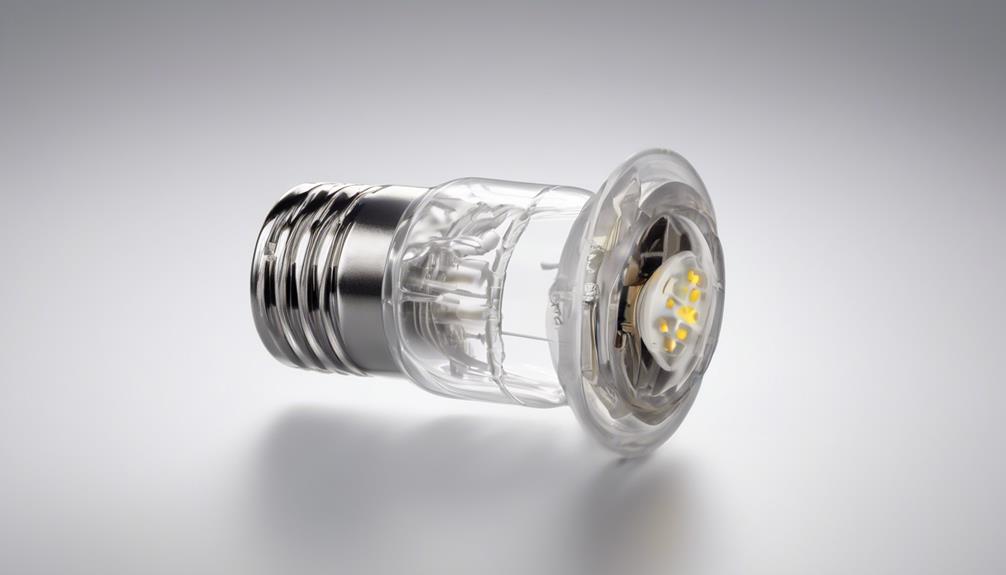
The G11 base's 4-pin configuration and electronic ballast compatibility pivot to the R7s base, which features a linear double-ended design commonly used in halogen and LED floodlights.
When it comes to R7s base installation, it's crucial to ensure that the bulb is securely inserted into the socket and properly aligned to prevent any electrical hazards. Additionally, regular maintenance of R7s base connections is essential to guarantee optimal performance and longevity of the lighting system. Proper cleaning and inspection of the contact points can help prevent flickering or intermittent connection issues.
Moreover, when handling R7s base maintenance, it's important to remember to disconnect the power source and allow the bulb to cool down before attempting any maintenance work to avoid the risk of electric shock or burns.
- Secure Installation: Ensure the bulb is firmly inserted and aligned in the socket.
- Regular Maintenance: Conduct routine cleaning and inspection of the contact points to prevent performance issues.
- Safety Precautions: Always disconnect power and allow the bulb to cool before performing any maintenance tasks.
B22 Base
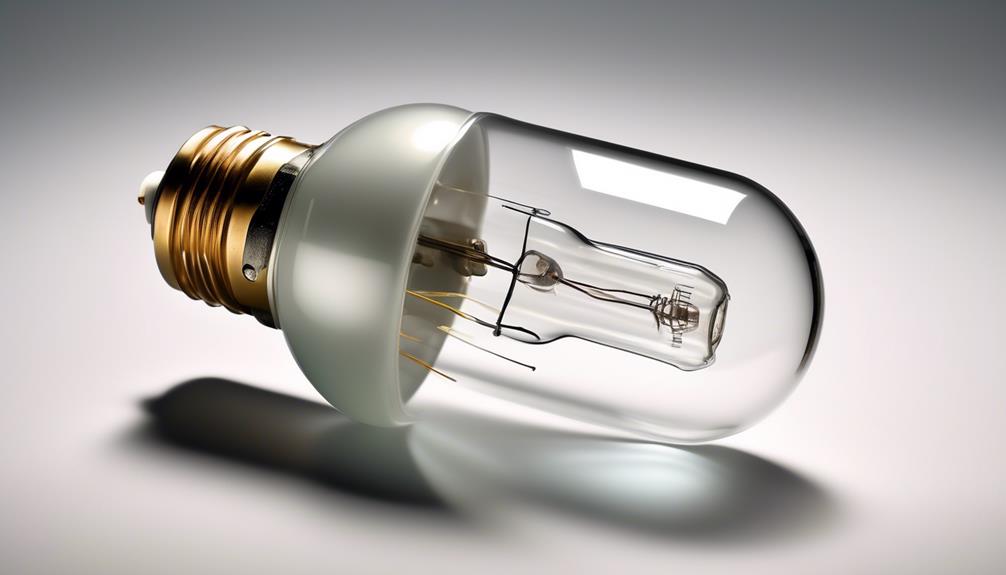
We can identify the B22 base by its bayonet mount and two pins for connecting to the electrical supply. The B22 base, also known as the bayonet mount, is a type of lamp fitting typically used in the United Kingdom and other countries. It's commonly found in incandescent, CFL, and LED bulbs. The base has two pins located at the bottom of the lamp, which are used to secure the bulb in the socket. The B22 base is designed to provide a secure and stable connection to the electrical supply.
In modern lighting technology, the B22 base is an important component for ensuring energy efficiency. It allows for the use of various types of energy-saving bulbs, including LED and CFL options. These bulbs are designed to consume less energy while providing the same level of brightness as traditional incandescent bulbs. By utilizing the B22 base with energy-efficient lighting solutions, consumers can significantly reduce their energy consumption and contribute to environmental sustainability.
Additionally, the ease of installation and replacement offered by the B22 base makes it a practical choice for residential and commercial lighting applications.
Frequently Asked Questions
Can I Use an E26 Base Bulb in a Fixture That Is Designed for an E12 Base?
Yes, you can use an E26 base bulb in a fixture designed for an E12 base. However, this is only possible if the voltage requirements of the bulb and the fixture are compatible. It is essential to check that the wattage and voltage of the bulb align with the specifications of the fixture to avoid any potential hazards. Always refer to the manufacturer's guidelines and consider seeking professional advice if you have any concerns about compatibility issues.
What Are the Common Applications for GU10 Base Bulbs?
We use GU10 base bulbs for various applications. These bulbs offer energy efficiency and come in a range of color options. They also have dimming capabilities, making them suitable for creating different atmospheres.
Additionally, GU10 bulbs are known for their spotlight and floodlight options, which make them versatile for accent lighting and general illumination. These bulbs are perfect for those who seek precise control and flexibility in their lighting setups.
Is a G4 Base Bulb Suitable for Outdoor Use?
Yes, a G4 base bulb can be suitable for outdoor use. It's commonly used in garden fixtures and outdoor lighting due to its compact size and versatility.
G4 bulbs are designed to withstand outdoor conditions, providing efficient and reliable illumination for outdoor spaces. They're a practical choice for enhancing the aesthetics and functionality of outdoor areas, offering a reliable lighting solution for various applications.
What Are the Advantages of Using a 2G11 Base Bulb Over Other Base Types?
Using a 2G11 base bulb offers several advantages over other base types. Its design allows for better energy efficiency and compatibility with various fixtures. The installation process is straightforward, and retrofit options are available for easy upgrades.
However, some disadvantages include limited availability of bulb options and compatibility issues with certain fixtures.
Can I Replace a B22 Base Bulb With a Different Base Type Without Modifying the Fixture?
Yes, socket compatibility is crucial when considering base type options.
While it's theoretically possible to replace a B22 base bulb with a different type without modifying the fixture, it's not advisable. Different base types may not fit securely or make proper electrical contact.
This could lead to safety hazards or unreliable performance.
It's always best to consult the fixture's specifications and use the recommended base type to ensure optimal function and safety.
Conclusion
In conclusion, understanding the different bulb base types is crucial for selecting the right light fixture for your needs.
Just like a carpenter needs the right tool for the job, choosing the correct bulb base ensures proper fit and functionality.
With the wide variety of base types available, it's important to know the specific requirements of your lighting setup to achieve optimal performance.
- About the Author
- Latest Posts
Introducing Ron, the home decor aficionado at ByRetreat, whose passion for creating beautiful and inviting spaces is at the heart of his work. With his deep knowledge of home decor and his innate sense of style, Ron brings a wealth of expertise and a keen eye for detail to the ByRetreat team.
Ron’s love for home decor goes beyond aesthetics; he understands that our surroundings play a significant role in our overall well-being and productivity. With this in mind, Ron is dedicated to transforming remote workspaces into havens of comfort, functionality, and beauty.
Appliances
Pancake Mix Box
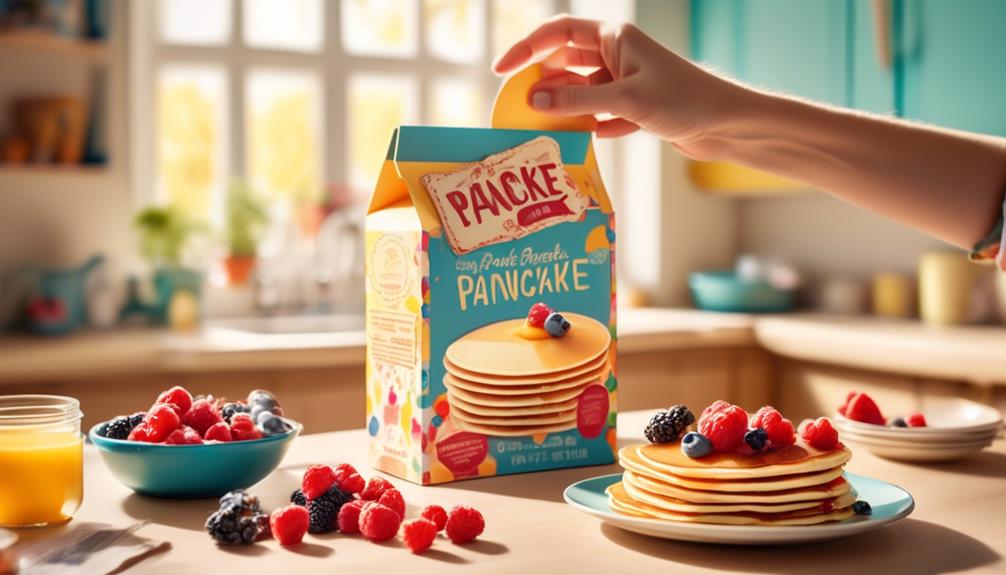
Have you ever experienced being in the breakfast aisle, looking at all the different pancake mix options, feeling overwhelmed? If so, you’re not the only one.
With so many different types of pancake mixes available, it can be challenging to know which one is the best choice for your breakfast preferences. But fear not, because we're here to help you navigate the world of pancake mix boxes and make informed decisions about the perfect pancake mix for your next morning meal.
Key Takeaways
- Checking the ingredient list and understanding the label breakdown of pancake mix boxes helps identify allergens and dietary restrictions and make informed dietary choices.
- Traditional pancake mixes typically include ingredients like flour, leavening agents, sugar, and salt, which contribute to the texture, flavor, and rise of the pancakes.
- Pancake mixes offer a versatile canvas for culinary creativity with various flavor variations, including sweet toppings, aromatic undertones, and savory options.
- When choosing gluten-free pancake mix options, it is important to consider health benefits, taste preferences, nutrient density, texture, and the certification of being gluten-free for safety.
Understanding Pancake Mix Labels
When reading pancake mix labels, always check the ingredient list for any allergens or dietary restrictions. The label breakdown provides crucial information about the nutritional value of the mix. Understanding pancake mix labels is essential for those seeking to master the art of making perfect pancakes.
The label breakdown typically includes the list of ingredients, serving size, calories per serving, and the amounts of key nutrients such as fat, protein, and carbohydrates. It's important to pay attention to the serving size as the nutritional values are often based on a single serving, and it may differ from the portion you intend to consume.
Analyzing the nutritional value helps in making informed dietary choices. It allows us to assess the macronutrient composition and consider factors like fiber content, sugar levels, and overall calorie intake. This information empowers us to select pancake mixes that align with our dietary goals and preferences.
Exploring Traditional Pancake Mixes

Let's begin by examining the ingredient analysis of traditional pancake mixes. This will allow us to uncover the variations in flavor profiles. Additionally, we will detail the cooking instructions for optimal results.
Ingredient Analysis
Traditional pancake mixes typically consist of a balanced blend of flour, leavening agents, sugar, salt, and sometimes added flavors or other ingredients. The ingredient breakdown and nutritional analysis of traditional pancake mixes can provide valuable insights into their composition and health implications. Here's what you need to know:
- Flour: Usually a combination of all-purpose flour and a small amount of cornstarch for a lighter texture.
- Leavening Agents: Baking powder and baking soda for the rise and fluffiness.
- Sugar: Adds sweetness and aids in browning.
- Salt: Enhances flavor and regulates the yeast activity.
Understanding these components allows for a more informed choice when selecting pancake mixes, especially for those with dietary restrictions or specific health goals.
Flavor Variations
Exploring traditional pancake mixes reveals a myriad of flavor variations that enhance the classic breakfast staple with innovative and diverse taste profiles.
When it comes to sweet toppings, ingredients such as chocolate chips, blueberries, or bananas can be added to the pancake batter, providing bursts of sweetness and fruity flavors. Additionally, incorporating cinnamon, nutmeg, or vanilla extract into the mix can infuse the pancakes with warm and aromatic undertones.
On the savory side, add-ins like cheddar cheese, cooked bacon, or scallions offer a delightful twist to the traditional pancake, creating a savory and satisfying option for breakfast or brunch.
These flavor variations allow for endless experimentation, catering to a wide range of preferences and palates, making the pancake mix a versatile canvas for culinary creativity.
Cooking Instructions
As we consider the flavor variations of pancake mixes, the cooking instructions for traditional mixes offer precise steps to ensure a perfect batch of fluffy, delicious pancakes. To achieve pancake perfection, follow these essential tips:
- Cooking Techniques: Use medium heat to cook pancakes evenly without burning. Pour the batter onto a preheated, lightly greased griddle or skillet.
- Perfect Flipping Techniques: Wait until bubbles form on the surface before flipping. Use a spatula to gently lift and flip the pancake, ensuring an even golden brown color on both sides.
- Best Toppings: Experiment with a variety of toppings such as fresh fruits, maple syrup, honey, or whipped cream for a delightful culinary experience.
- Time-Saving Hacks: Prepare the dry ingredients the night before to save time in the morning. Consider using a preheated non-stick griddle for faster cooking.
Discovering Gluten-Free Options
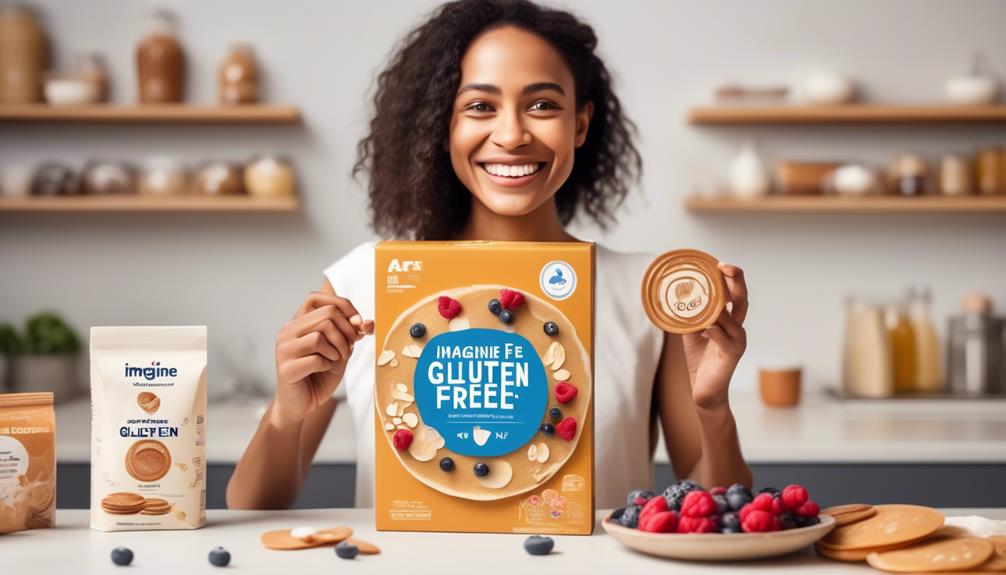
We've found that gluten-free pancake mix offers a great alternative for those with dietary restrictions. The benefits of gluten-free options are numerous, including improved digestion and overall wellness.
We'll also share some tasty and innovative gluten-free recipes to make the most of this option.
Gluten-Free Pancake Mix
Discovering gluten-free options for pancake mix has opened up a world of possibilities for those with dietary restrictions. For those seeking gluten-free alternatives, it's essential to consider the health benefits and taste preferences.
When exploring gluten-free pancake mix, it's important to focus on the following key aspects:
- Nutrient Density: Look for mixes fortified with essential nutrients like iron, calcium, and fiber to compensate for the lack of enrichment found in traditional wheat-based mixes.
- Texture and Fluffiness: Opt for mixes that provide a light and fluffy texture, similar to traditional pancakes, ensuring an enjoyable eating experience.
- Natural Ingredients: Choose mixes made from wholesome, natural ingredients to ensure a cleaner, healthier option without compromising on taste or texture.
- Certifications: Seek out mixes that are certified gluten-free to guarantee safety for individuals with celiac disease or gluten sensitivities.
Exploring these aspects can help individuals find a gluten-free pancake mix that not only meets their dietary restrictions but also delivers on taste and quality.
Benefits of Gluten-Free
In our quest for gluten-free options, we have uncovered numerous benefits that offer a fresh perspective on dietary choices and health. Embracing a gluten-free diet can bring about various health benefits, especially for individuals with gluten sensitivities or celiac disease. Here are some of the key gluten-free benefits and health benefits:
| Gluten-Free Benefits | Health Benefits | Improved Digestion |
|---|---|---|
| Reduced Inflammation | Enhanced Nutrient Absorption | Increased Energy Levels |
| Weight Management | Better Digestive Health | Enhanced Mental Clarity |
Adopting a gluten-free lifestyle can lead to reduced inflammation, improved digestion, and better overall health. By eliminating gluten, individuals may experience enhanced nutrient absorption, increased energy levels, and improved digestive health. Moreover, it can contribute to better weight management and enhanced mental clarity. These benefits underscore the significance of considering gluten-free options for a healthier lifestyle.
Tasty Gluten-Free Recipes
Embracing a gluten-free lifestyle unlocks a world of delicious and innovative recipes that cater to diverse dietary preferences and offer a fresh perspective on culinary choices. When it comes to gluten-free pancake mix, the options are endless.
Here are some tasty gluten-free recipes to elevate your pancake experience:
- Lemon Blueberry Bliss – Top your gluten-free pancakes with a zesty lemon glaze and fresh blueberries for a burst of sweet and tangy flavor.
- Savory Spinach and Feta Filling – Incorporate sautéed spinach and crumbled feta cheese into the pancake batter for a savory twist.
- Banana Nut Delight – Mix chopped walnuts and ripe bananas into the batter for a delightful combination of sweet and nutty flavors.
- Satisfying Breakfast Burrito – Use gluten-free pancakes as a wrap and fill them with scrambled eggs, avocado, and salsa for a hearty and savory breakfast option.
Uncovering Protein-Packed Varieties
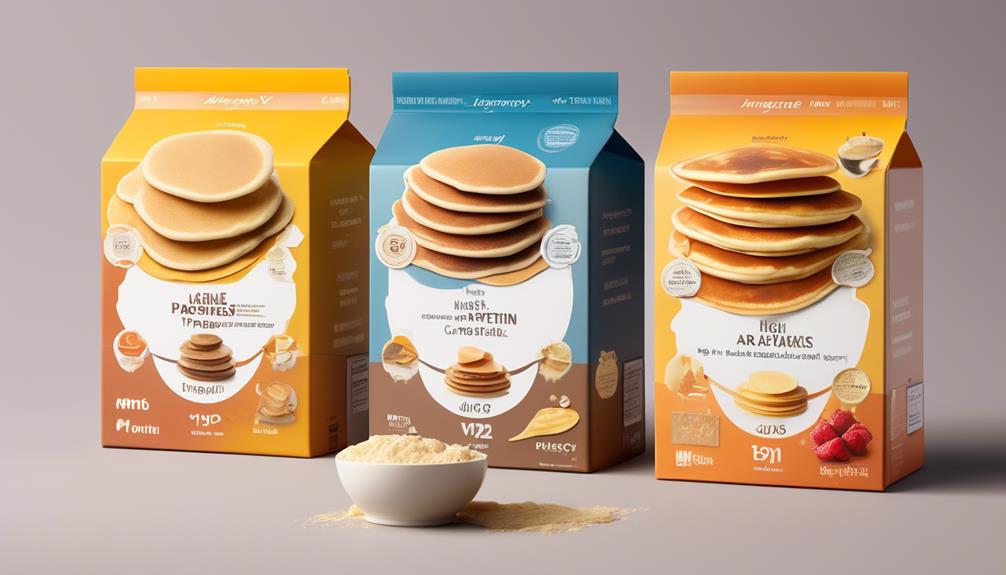
Among the various pancake mix options, those boasting high protein content have become increasingly sought after by health-conscious consumers. When it comes to protein-packed varieties, it's essential to consider various factors such as protein sources, nutritional value, taste preferences, and cooking techniques. To provide a comprehensive overview, we have compiled a table comparing different protein-packed pancake mixes available in the market.
| Pancake Mix | Protein Source | Nutritional Value | Taste Preferences |
|---|---|---|---|
| Mix A | Whey protein isolate | High protein, low carb, low sugar | Light and fluffy |
| Mix B | Plant-based blend | Rich in fiber, moderate protein | Nutty and wholesome |
| Mix C | Quinoa and chia seeds | Balanced protein and omega-3 fats | Earthy and hearty |
| Mix D | Greek yogurt powder | High protein, probiotics | Creamy and tangy |
These protein-packed varieties offer a diverse range of options for consumers with varying dietary needs and taste preferences. Whether you're seeking a high-protein, low-carb option or a plant-based, fiber-rich blend, there are pancake mixes available to suit your preferences. Additionally, experimenting with different cooking techniques such as adding fruits, nuts, or protein toppings can further enhance the nutritional value and taste of these protein-packed pancakes.
Evaluating Sweet and Savory Flavors
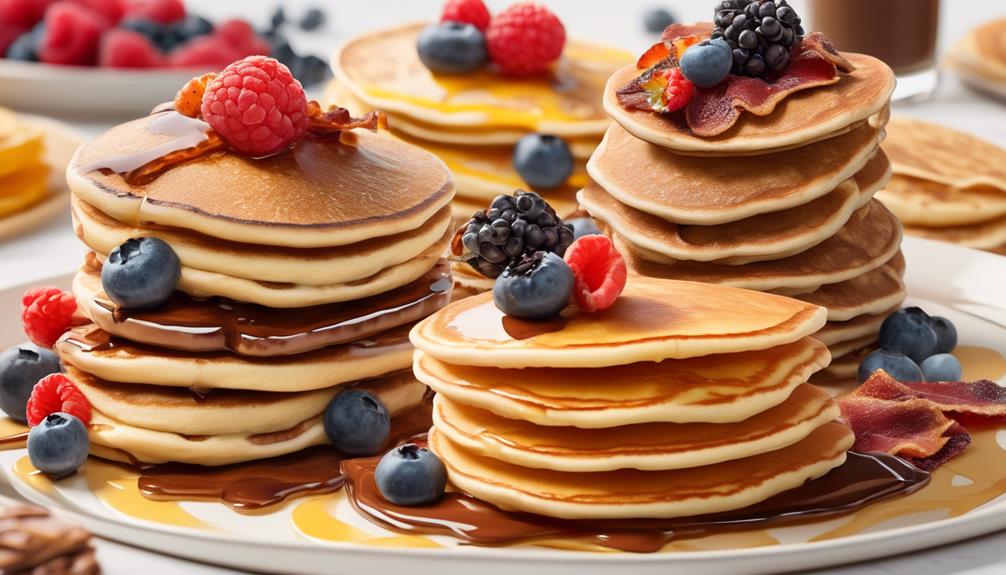
We will assess the sensory characteristics of both sweet and savory flavors in pancake mixes to discern their appeal to consumers seeking diverse taste experiences.
- Sweet Toppings: Experiment with a range of sweet toppings like fruits, syrups, and whipped cream to complement the natural sweetness of the pancake batter.
- Savory Fillings: Explore savory fillings such as cheese, bacon, or vegetables to create unique combinations that appeal to those with a preference for more savory flavors.
- Flavor Pairings: Consider the balance of flavors when pairing sweet and savory elements to create harmonious taste profiles that cater to a variety of palate preferences.
- Recipe Ideas: Provide innovative recipe ideas that incorporate both sweet and savory elements, offering consumers a diverse range of culinary experiments to try.
Taste testing these flavor profiles can reveal insights into consumer preferences, guiding chef recommendations for creating pancake mixes that offer a balance of sweet and savory options. Understanding palate preferences will enable the development of unique combinations that cater to the diverse tastes of consumers.
Comparing Organic and Non-GMO Choices
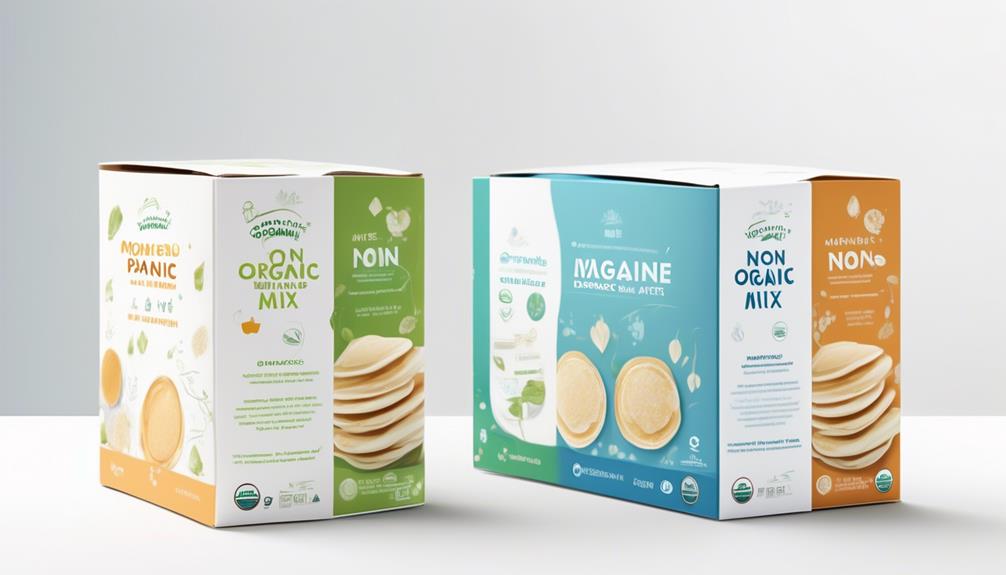
After evaluating the sensory characteristics of sweet and savory flavors in pancake mixes, our focus now shifts to comparing the attributes of organic and non-GMO choices, aiming to provide consumers with transparent information about the ingredients and production methods used in these options.
When considering health benefits and nutritional value, organic pancake mixes offer distinct advantages. They're made from ingredients grown without synthetic pesticides or fertilizers, which can result in higher levels of certain nutrients and antioxidants. Additionally, organic pancake mixes are free from genetically modified organisms (GMOs), providing reassurance to consumers concerned about the potential long-term health effects of GMO consumption.
Non-GMO pancake mixes, while not necessarily organic, also provide health benefits by excluding genetically modified ingredients. However, it's important to note that the nutritional value of non-GMO pancake mixes may not be as comprehensive as organic options due to the potential use of synthetic pesticides and fertilizers in the farming process.
Ultimately, both organic and non-GMO pancake mixes offer healthier alternatives to conventional options, but organic choices generally provide a more comprehensive approach to health and nutritional benefits.
Tips for Perfect Pancakes Every Time
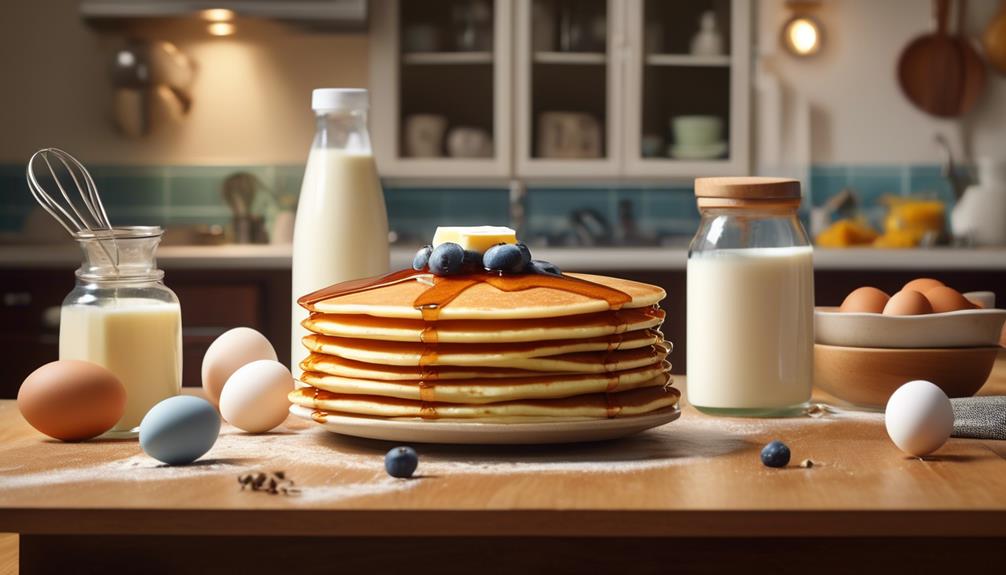
To achieve consistently perfect pancakes, start by preheating the griddle or pan to the recommended temperature. This ensures even cooking and prevents the pancakes from sticking. Once the griddle is ready, follow these tips for perfect pancakes every time:
- Batter Consistency: Achieving the right batter consistency is crucial. The batter should be thick enough to hold its shape on the griddle but also spread slightly to form a perfect circle. Adjust the amount of liquid in the batter to achieve the desired consistency.
- Flipping Techniques: Use a wide spatula to flip the pancakes. Wait until the edges look set and bubbles form on the surface before flipping. A gentle and swift motion is key to a successful flip, ensuring the pancake cooks evenly on both sides.
- Even Cooking: Pour the batter onto the griddle using a measuring cup or ladle to ensure consistent pancake sizes. This helps in achieving even cooking and uniform shape.
- Temperature Control: Maintain a consistent temperature throughout the cooking process. Adjust the heat as needed to prevent burning and ensure that the pancakes are cooked through evenly.
Frequently Asked Questions
Can Pancake Mix Be Used to Make Other Recipes Besides Pancakes?
Yes, pancake mix can be used to create a variety of creative recipes. Its versatile uses extend beyond just pancakes and can be incorporated into dishes such as waffles, muffins, and even savory recipes like crispy chicken tenders.
The mix provides a convenient base for experimenting with different flavors and textures. Its adaptability makes it a valuable ingredient for those seeking to elevate their culinary skills and expand their recipe repertoire.
Are There Any Pancake Mixes That Cater to Specific Dietary Restrictions, Such as Nut Allergies or Vegan Diets?
We've found some exciting developments in the world of pancake mixes!
There are now vegan options available that cater to specific dietary restrictions, such as nut allergies.
Additionally, some brands offer allergy-friendly alternatives, ensuring that everyone can enjoy delicious pancakes without worrying about allergens.
These innovative products are a testament to the evolving landscape of food options, providing a technical and precise solution for those with dietary restrictions.
How Long Does Pancake Mix Typically Last Before It Expires?
Pancake mix typically lasts for about 6-12 months before it expires, depending on the specific product and storage conditions. To maximize shelf life, store pancake mix in a cool, dry place, and ensure the packaging is sealed tightly.
Exposure to moisture, heat, or air can accelerate spoilage. Proper storage is crucial for maintaining the quality and safety of pancake mix.
Can Pancake Mix Be Used to Make Waffles Instead of Pancakes?
Absolutely, pancake mix can be used to make waffles instead of pancakes. It's a versatile option that can be readily substituted in waffle recipes.
Are There Any Unique or Unconventional Flavors of Pancake Mix Available on the Market?
There are many unconventional flavors of pancake mix available on the market. Creative recipes and flavor innovations have led to unique options such as matcha green tea, red velvet, and even birthday cake flavored pancake mixes.
These trends in pancake mix offer a wide range of options for those seeking new and exciting flavors to try at breakfast time.
Conclusion
In conclusion, the pancake mix box offers a wide range of options for every taste and dietary preference. From traditional to gluten-free, protein-packed, and sweet or savory flavors, there's something for everyone.
With the right tips and techniques, perfect pancakes can be achieved every time. So next time you're at the grocery store, don't overlook the pancake mix aisle – you might just find your new favorite breakfast treat.
- About the Author
- Latest Posts
Introducing Ron, the home decor aficionado at ByRetreat, whose passion for creating beautiful and inviting spaces is at the heart of his work. With his deep knowledge of home decor and his innate sense of style, Ron brings a wealth of expertise and a keen eye for detail to the ByRetreat team.
Ron’s love for home decor goes beyond aesthetics; he understands that our surroundings play a significant role in our overall well-being and productivity. With this in mind, Ron is dedicated to transforming remote workspaces into havens of comfort, functionality, and beauty.
-

 Vetted1 week ago
Vetted1 week ago15 Best Printers of 2024: Top Picks and Expert Reviews
-

 Vetted1 week ago
Vetted1 week ago15 Best Tile Sealers for Long-Lasting Protection and Shine
-

 Vetted2 weeks ago
Vetted2 weeks ago15 Best Smelling Floor Cleaners That Will Leave Your Home Fresh and Inviting
-

 Vetted1 day ago
Vetted1 day ago14 Best Lawn Tractors of 2024 – Ultimate Guide for Your Yard Maintenance
-

 Vetted2 weeks ago
Vetted2 weeks ago14 Best Power Scrubbers for Showers That Will Transform Your Cleaning Routine
-

 Vetted4 days ago
Vetted4 days ago15 Best Evergreen Plants for Shade Gardens: A Complete Guide
-

 Vetted4 days ago
Vetted4 days ago15 Best LED Dimmer Switches With No Flicker: Ultimate Guide for a Flicker-Free Lighting Experience
-

 Mardi Gras Decoration6 days ago
Mardi Gras Decoration6 days agoWhat Do the Symbols of Mardi Gras Mean?























